
The Solar-Terrestrial Centre of Excellence (STCE) is a collaborative network of the Belgian Institute for Space Aeronomy, the Royal Observatory of Belgium and the Royal Meteorological Institute of Belgium.
 |
Published by the STCE - this issue : 11 Oct 2012. The Solar-Terrestrial Centre of Excellence (STCE) is a collaborative network of the Belgian Institute for Space Aeronomy, the Royal Observatory of Belgium and the Royal Meteorological Institute of Belgium. |
| Archive of the newsletters | Subscribe to this newsletter by mail |
In the morning hours of 5 October, the Sun produced a relatively weak B7.8 flare. Interesting were its atypical x-ray evolution and its very long duration. Indeed, starting at 03:17UT, it reached its maximum x-ray intensity only at 07:30UT. Ending at 10:46UT, the flare lasted for a whopping 7 hours and 29 minutes, and that begged for some closer examination. As it turns out, this was a very complex event.
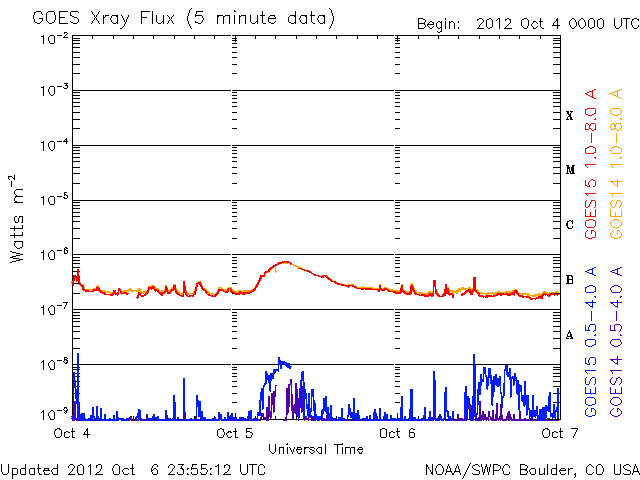
In white light, the Sun appeared very quiet, with only 3 inactive sunspot groups in the area: NOAA 1579 and 1582, each consisting of a big, but single sunspot, and –more to the southeast (bottom left) of NOAA 1582- the very small and decaying NOAA 1584. In H-alpha (the “cold” chromosphere), some fairly small filaments could be seen, with a prominent dark cloud near the southern solar pole and a dynamic filament to the east of NOAA 1582. The transition region and corona (extreme ultraviolet – EUV) showed a distinct coronal hole to the east (left) of the sunspot regions. There were also two pseudo-coronal holes, the smaller one being very close to NOAA 1584.
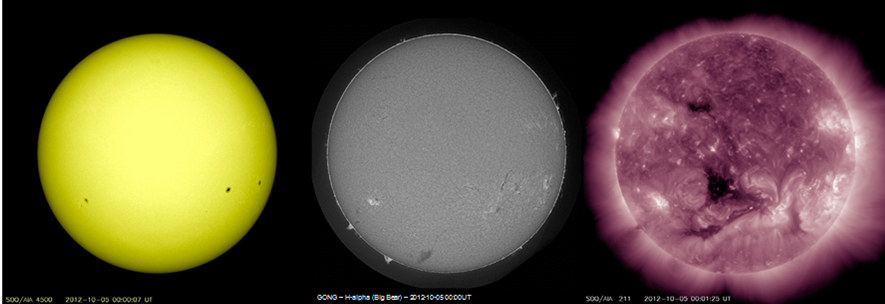
Using different colors, all these features can be put on a magnetogram. This gives an idea on their magnetic polarity (white is positive, black is negative). Sunspots are green, (H-alpha) filaments red, coronal holes are blue and the outlines of the pseudo coronal holes are in dashed orange. The yellow spots are regions showing up brightly in EUV (SDO/AIA 171), mostly corresponding to the sunspot regions. Noticeable are two large areas of opposite magnetic polarity. The "black" magnetic region contains the coronal hole (CH) and one of the pseudo CH, as well as the trailing part of the sunspot group NOAA 1584 (which is spotless). The "white" magnetic region contains the other pseudo CH and all the aforementioned sunspots. The neutral line separating these magnetic areas runs for 100.000's km, but only at the outer ends and near NOAA 1584, filaments can be seen. The hotter chromosphere (SDO/AIA 304) shows more material (brown) along this inversion line, trapped between the opposing magnetic fields.
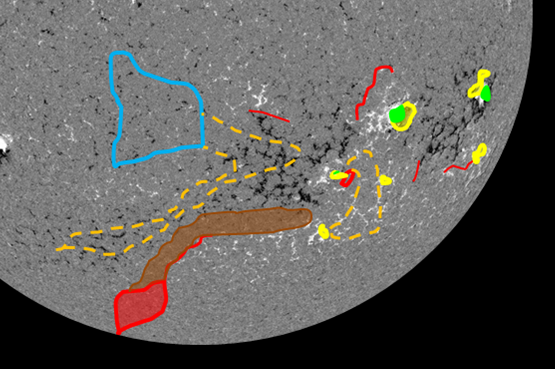
This movie http://www.youtube.com/watch?v=twU4farTLCs shows the evolution of the event from 00:00 till 15:00UT, in successively higher temperatures (and thus altitudes). In the "hot chromosphere" (AIA 304; 50.000 degrees), southward movement of material along the inversion line into the H-alpha filament blob near the southern pole can be seen. This happens between midnight and 3 o'clock, so well before the onset of the flare. The flare itself is visible as a diffuse parallel ribbon flare, resulting from coronal material raining down into the much denser chromosphere. The brightest parts are about midway of the inversion line, near NOAA 1584. The filament near NOAA 1582 is very dynamic too, with eruptions around 06:15UT and 07:45UT.
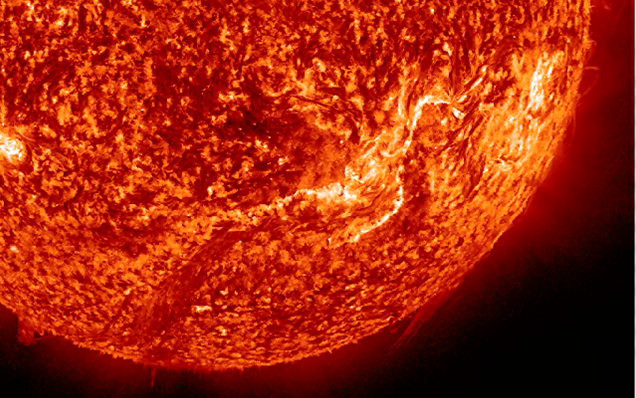
In the transition zone (AIA 171; 650.000 degrees) as well as in the corona (AIA 211; 2 million degrees), the material movement and the parallel ribbon flare are not so well visible. Only the ribbon bordering to the east side of the small pseudo CH can be more or less distinguished. However, two other features are claiming all attention. The first is a bright coronal loop emanating from the leading part of NOAA 1584, and crossing the magnetic inversion line. This one has not even completely disappeared, or another dynamic bundle of coronal loops springs from the *trailing* (spotless) part of NOAA 1584 towards a region between NOAA 1582's big spot and the dynamic filament. These 2 loop bundles appear well after the maximum in x-ray intensity (resp. between 07:00 and 10:30UT, and between 10:00 and 13:30UT).

The AIA 221 clip also shows how a series of fine coronal loops gradually obscure the small pseudo CH (starting around 10:30UT). Indeed, at the end of the clip, the feature has almost completely gone from view! The AIA 221 clip also provides a crisp view on the H-alpha filament blob near the Sun’s southern pole. It is visible as a fine-ragged web of tiny, dark (cold) filament strands.
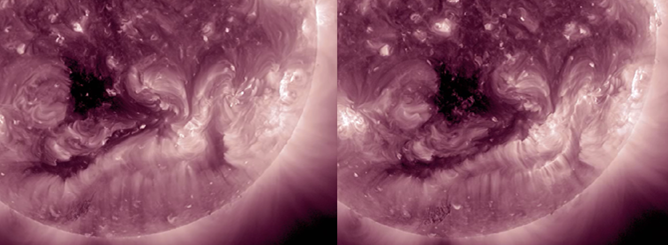
One more amazing thing about this long duration event: The (Earth-directed) coronal mass ejection associated with the flare was visible *before* the x-ray enhancement actually started! As can be seen in the STEREO-A movie, the ejected plasma cloud is already showing up in the coronagraph at around 02:30UT, more than 45 minutes before the onset of the flare. The speed was measured to be 550 km/s, indicating that the magnetic reconnection, which is at the base of all these events, took place shortly after midnight.
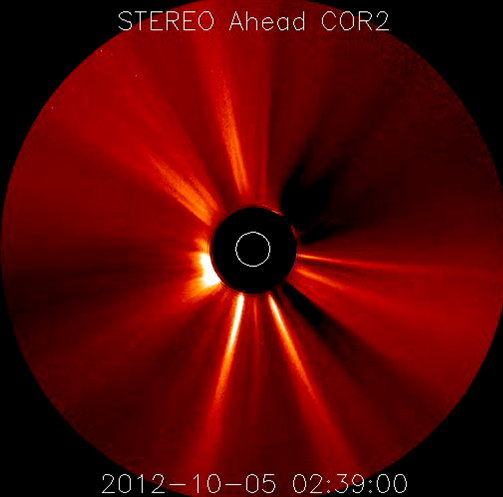
Nine sunspot groups were reported during the week: NOAA ARs 1575, 1577, 1578, 1579, 1582, 1583, 1584, 1585, and 1586. Numerous C-class flares were observed in the NOAA AR 1575 on October 1, the strongest ones being the two C4.8 flares
peaking at 01:47 UT and 13:13 UT. Another C-class flare (C1.1) was observed in the NOAA AR 1582 on October 2. After that solar flaring activity was below the C-level until October 7, when a C1.2 flare was observed in an active region behind the north-east limb. This flare was associated with a partial halo CME (see below).
A partial halo CME (angular width around 200 degrees) was detected by SOHO/LASCO on October 5, first seen in the LASCO C2 field of view at 02:48 UT. GOES detected a long-duration B7.5 flare peaking at 07:32 UT (with a long rise time). SDO/AIA images show corresponding post-eruption loops in the NOAA AR 1584, as well as post-eruption loops connecting NOAA ARs 1582 and 1584. The CME speed measured in the LASCO data was around 550 km/s. The corresponding ICME arrived at the Earth early on October 8.
Another partial halo CME (angular width around 150 degrees) first appeared in the SOHO/LASCO C2 field of view at 20:36 UT on October 7. It was associated with the C1.2 flare from the active region just behind the north-east limb (see above). The CME is therefore a limb backside CME and is not expected to arrive at the Earth.
A small low-latitude coronal hole in the southern hemisphere reached the solar central meridian on October 5. The fast solar wind flow emanating from it arrived at the Earth on October 9.
The week started with a geomagnetic storm (Kp = 7 reported by NOAA and local K = 5 reported by Dourbes and IZMIRAN) following the arrival of an interplanetary shock wave detected on September 30 by ACE around 22:15 UT and by SOHO/CELIAS at 22:21 UT. The shock was driven by the ICME corresponding to the full halo CME observed on the Sun on September 28. The interplanetary magnetic field (IMF) magnitude in the ICME reached 22 nT and was directed southward right after the shock, with the north-south IMF component Bz reaching -20 nT. Later on October 1 the IMF magnitude decreased and geomagnetic conditions became quiet. Geomagnetic situation remained quiet throughout the rest of the week as the Earth was passing through a very slow solar wind flow.
Invited talk in the session Solar Magnetism and the Solar Cycle.
http://www.spaceweather.eu/en/repository/show?id=253
Presentatie over de 24ste zonnecyclus voor leden van de volkssterrenwacht Urania in het kader van hun wekelijkse voordrachten. Een basiskennis is vereist.
http://www.spaceweather.eu/en/repository/show?id=254
Presentatie over de zon voor leden van de volkssterrenwacht MIRA in het kader van een cursus sterrenkunde. Een basiskennis is vereist.
http://www.spaceweather.eu/en/repository/show?id=255
Talk in the session Solar magnetism and the solar cycle
http://www.spaceweather.eu/en/repository/show?id=256
Talk in the session Solar Magnetism and the Solar Cycle
http://www.spaceweather.eu/en/repository/show?id=257
Talk in the session Solar Magnetism and the Solar Cycle
http://www.spaceweather.eu/en/repository/show?id=258
Talk in the session Solar Magnetism and the Solar Cycle
http://www.spaceweather.eu/en/repository/show?id=259
Talk in the session Solar Magnetism and the Solar Cycle
http://www.spaceweather.eu/en/repository/show?id=260
Talk in the session Processes of slow/steady energy release in the solar atmosphere and heliosphere
http://www.spaceweather.eu/en/repository/show?id=261
Talk in the session Processes of slow/steady energy release in the solar atmosphere and heliosphere
http://www.spaceweather.eu/en/repository/show?id=262
Talk in the session Processes of slow/steady energy release in the solar atmosphere and heliosphere
http://www.spaceweather.eu/en/repository/show?id=263
Talk in the session Processes of slow/steady energy release in the solar atmosphere and heliosphere
http://www.spaceweather.eu/en/repository/show?id=264
Talk in the session Processes of slow/steady energy release in the solar atmosphere and heliosphere
http://www.spaceweather.eu/en/repository/show?id=265
Talk in the session Processes of slow/steady energy release in the solar atmosphere and heliosphere
http://www.spaceweather.eu/en/repository/show?id=266
Invited talk in the session Processes of slow/steady energy release in the solar atmosphere and heliosphere
http://www.spaceweather.eu/en/repository/show?id=267
Invited talk in the session Processes of slow/steady energy release in the solar atmosphere and heliosphere
http://www.spaceweather.eu/en/repository/show?id=268
Talk in the session Processes of slow/steady energy release in the solar atmosphere and heliosphere
http://www.spaceweather.eu/en/repository/show?id=269
Invited talk in the session Eruptive processes in the solar atmosphere and their manifestations in the heliosphere
http://www.spaceweather.eu/en/repository/show?id=270
Talk in the session Eruptive processes in the solar atmosphere and their manifestations in the heliosphere
http://www.spaceweather.eu/en/repository/show?id=271
Talk in the session Eruptive processes in the solar atmosphere and their manifestations in the heliosphere
http://www.spaceweather.eu/en/repository/show?id=272
Invited talk in the session Eruptive processes in the solar atmosphere and their manifestations in the heliosphere
http://www.spaceweather.eu/en/repository/show?id=273
Talk in the session Eruptive processes in the solar atmosphere and their manifestations in the heliosphere
http://www.spaceweather.eu/en/repository/show?id=274
Talk in the session Eruptive processes in the solar atmosphere and their manifestations in the heliosphere
http://www.spaceweather.eu/en/repository/show?id=275
Talk in the session Eruptive processes in the solar atmosphere and their manifestations in the heliosphere
http://www.spaceweather.eu/en/repository/show?id=276
Talk in the session Eruptive processes in the solar atmosphere and their manifestations in the heliosphere
http://www.spaceweather.eu/en/repository/show?id=277
Invited talk in the session Eruptive processes in the solar atmosphere and their manifestations in the heliosphere
http://www.spaceweather.eu/en/repository/show?id=278
Talk in the session Eruptive processes in the solar atmosphere and their manifestations in the heliosphere
http://www.spaceweather.eu/en/repository/show?id=279
Talk in the session Eruptive processes in the solar atmosphere and their manifestations in the heliosphere
http://www.spaceweather.eu/en/repository/show?id=281
Talk in the session Eruptive processes in the solar atmosphere and their manifestations in the heliosphere
http://www.spaceweather.eu/en/repository/show?id=282
Talk in the session Data assimilation, visualization and analysis
http://www.spaceweather.eu/en/repository/show?id=283
Invited talk in session Data assimilation, visualization and analysis
http://www.spaceweather.eu/en/repository/show?id=285
Talk in session Data assimilation, visualization and analysis
http://www.spaceweather.eu/en/repository/show?id=286
Talk in session Data assimilation, visualization and analysis
http://www.spaceweather.eu/en/repository/show?id=287
Talk in session Data assimilation, visualization and analysis
http://www.spaceweather.eu/en/repository/show?id=288
Invited talk in session Data assimilation, visualization and analysis
http://www.spaceweather.eu/en/repository/show?id=289
Invited talk given in the Session Solar Magnetism and the solar cycle
http://www.spaceweather.eu/en/repository/show?id=290
Talk in the session Eruptive processes in the solar atmosphere and their manifestations in the heliosphere.
http://www.spaceweather.eu/en/repository/show?id=291
Talk in session Data assimilation, visualization and analysis
http://www.spaceweather.eu/en/repository/show?id=292
Talk given in the Session Processes of slow/steady energy release in the solar atmosphere and heliosphere
http://www.spaceweather.eu/en/repository/show?id=293
Invited talk in the session Eruptive processes in the solar atmosphere and their manifestations in the heliosphere
http://www.spaceweather.eu/en/repository/show?id=294
Talk in the session Eruptive processes in the solar atmosphere and their manifestations in the heliosphere
http://www.spaceweather.eu/en/repository/show?id=295
Talk in the session Eruptive processes in the solar atmosphere and their manifestations in the heliosphere
http://www.spaceweather.eu/en/repository/show?id=280
The propagation behavior of coronal mass ejections (CMEs) in interplanetary (IP) space is mainly influenced by the ambient solar wind flow. The interaction of CMEs with the solar wind can be expressed as drag force and manifests itself to decelerate CMEs that are faster than the ambient solar wind, whereas slower ones are accelerated until the CME speed is finally adjusted to the solar wind speed. With the SECCHI instrument suite aboard STEREO, CMEs can be observed during their entire propagation way from Sun to 1AU. The derived kinematical profile and its changes may be interpreted as interaction with high speed solar wind streams as well as other coronal mass ejections.
http://www.spaceweather.eu/en/repository/show?id=296
http://www.spaceweather.eu/en/repository/show?id=297
Start : 2013-01-14 - End : 2013-01-17
The Atacama Large Millimeter/submillimeter Array (ALMA), an
international partnership of Europe, North America and East Asia in
cooperation with the Republic of Chile, is the largest astronomical
project in existence.
The workshop aims to bring together the ALMA-minded solar
community to discuss solar observational issues with ALMA, solar
science and planned observations with ALMA, and the planning of
solar ALMA observations.
Th workshop is hosted by Astronomy & Astrophysics Group,
and will take place in School of Physics and Astronomy, University
of Glasgow, Room 323, Kelvin Building.
Website:
http://www.astro.gla.ac.uk/~eduard/solarALMA/
Start : 2013-04-08 - End : 2013-04-12
The most recent solar minimum, solar cycle 23-24 minimum, was
unusually long (266 spotless days in 2008, the most since 1913),
and the magnetic field at the solar poles was approximately 40%
weaker than the last cycle; and unusually complex (the solar wind
was characterized by a warped
heliospheric current sheet, HCS, and fast-wind
streams at low latitudes: the
fast-wind
threads the ecliptic
more commonly in 2008 than 1996.)
This complexity resulted in many effects observed from Sun to
Earth, with many observations indicating unusual conditions on the
Sun, in the heliosphere
, and in the magnetosphere
, ionosphere
, and upper atmosphere of the
Earth.
This remarkable set of conditions provide the scientific
community with an exceptional opportunity to assess the nature and
structure of a very quiet Sun, and an upper atmosphere relatively
devoid of solar influences, helping to provide a better
understanding of the relative roles of solar activity and internal
variability in the dynamics of the Earth's upper atmosphere and
ionosphere
. Such an understanding requires a
multidisciplinary approach.
The main goal of the conference is to bring together the solar,
heliospheric, magnetospheric, upper atmosphere, and ionospheric
communities to debate and discuss interdisciplinary work and reach
a better understanding of the nature and structure of a very quiet
Sun, and of an upper atmosphere relatively devoid of solar
influences, and in doing so, to help clarify the role of solar
activity in the dynamics and variability of the Earth's upper
atmosphere and ionosphere
relative to the internal
variations.
Website:
http://chapman.agu.org/solarminimum/
Start : 2013-05-06 - End : 2013-05-10
In the last 50 years, helioseismology has made significant
contributions to the knowledge of the Sun's interior physics
and has led the way to asteroseismology. We have now reached an era
where more sophisticated questions are being asked to understand
the subtle properties of the Sun and other stars due to the
synoptic and high-resolution observations available from BISON,
GONG and space missions such as SOHO
, SDO, CoRot and Kepler.
On this occasion, a workshop on the theme of '50 years of the
seismology of the Sun and stars' is being organized to reflect the
progress that has been made as well as to focus on future goals. We
plan to bring together helio- and asteroseismologists, theorists
and observers in a journey that will take us from the interior of
the Sun and its magnetism towards the structure of distant stars
and activity cycles.
Website:
http://www.nso.edu/workshops/2013